Flight Centre: Comprehensive Business Analysis and Strategies Report
VerifiedAdded on 2020/04/01
|16
|3357
|40
Report
AI Summary
This report provides a comprehensive analysis of Flight Centre, a major player in the air ticketing industry. It begins with an executive summary, outlining the report's scope, which includes an examination of Flight Centre's business environment, industry dynamics, legal and external factors, and strategic positioning. The report delves into the company's strengths, weaknesses, opportunities, and threats (SWOT), as well as a PEST analysis to assess the political, economic, social, and technological factors impacting its operations. Porter's Five Forces analysis is used to understand the competitive landscape. The report also covers Flight Centre's objectives, strategies, and business risks, followed by a ratio analysis to compare its financial performance with industry averages. The report concludes with a discussion of management and governance aspects, providing a holistic view of Flight Centre's business operations and strategic challenges. The report also offers insights into the regulatory environment and its impact on the company.
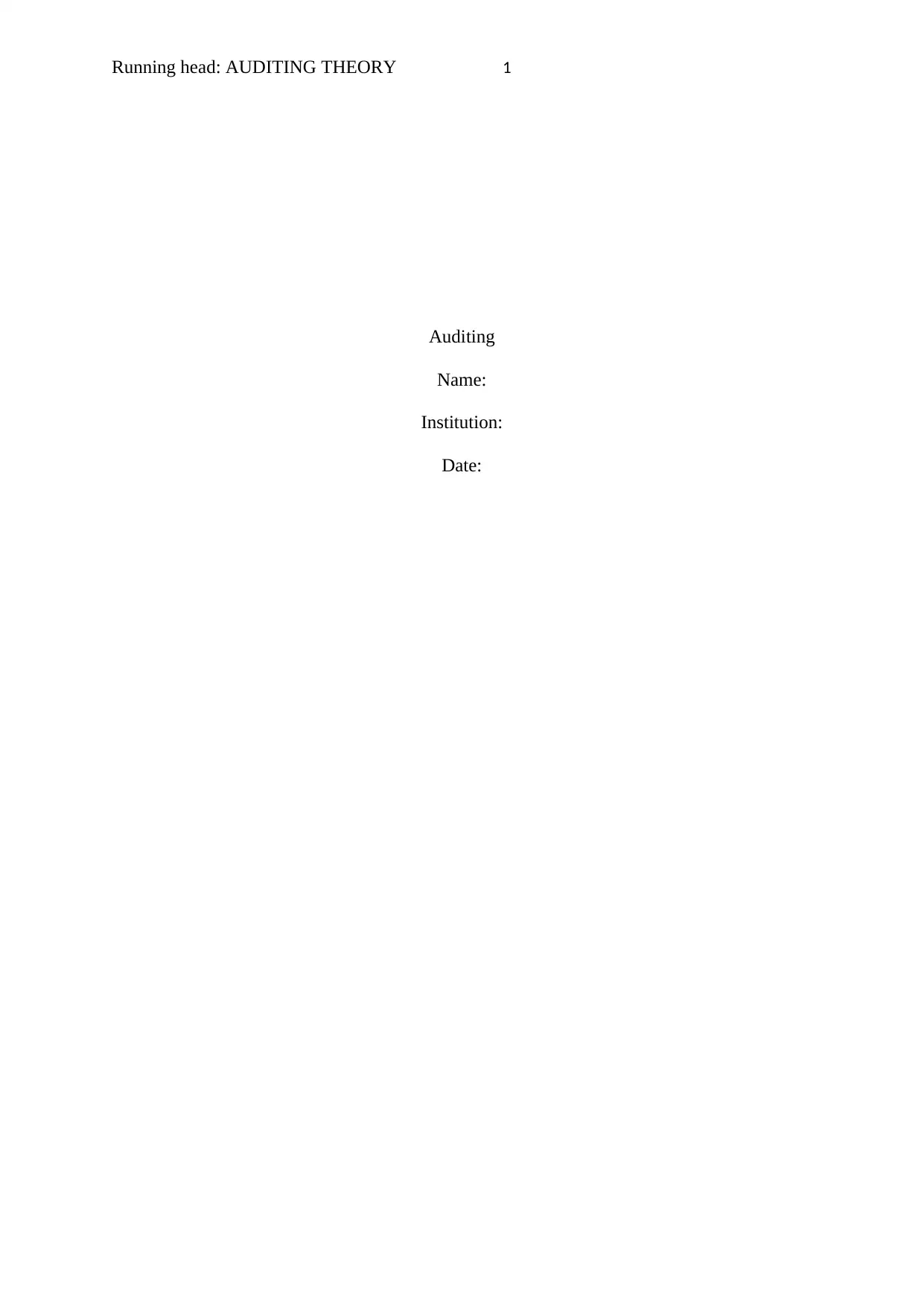
Running head: AUDITING THEORY 1
Auditing
Name:
Institution:
Date:
Auditing
Name:
Institution:
Date:
Paraphrase This Document
Need a fresh take? Get an instant paraphrase of this document with our AI Paraphraser
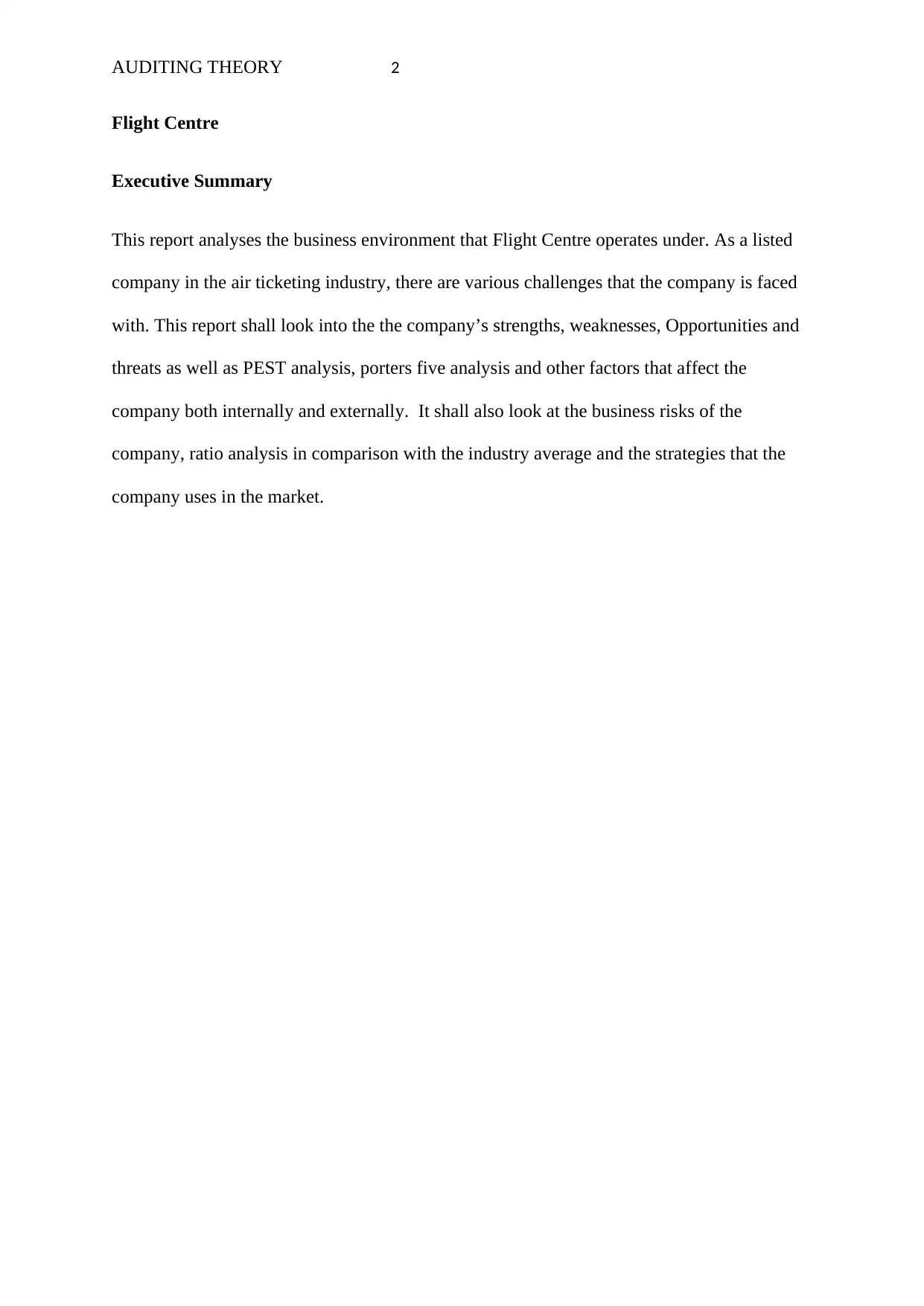
AUDITING THEORY 2
Flight Centre
Executive Summary
This report analyses the business environment that Flight Centre operates under. As a listed
company in the air ticketing industry, there are various challenges that the company is faced
with. This report shall look into the the company’s strengths, weaknesses, Opportunities and
threats as well as PEST analysis, porters five analysis and other factors that affect the
company both internally and externally. It shall also look at the business risks of the
company, ratio analysis in comparison with the industry average and the strategies that the
company uses in the market.
Flight Centre
Executive Summary
This report analyses the business environment that Flight Centre operates under. As a listed
company in the air ticketing industry, there are various challenges that the company is faced
with. This report shall look into the the company’s strengths, weaknesses, Opportunities and
threats as well as PEST analysis, porters five analysis and other factors that affect the
company both internally and externally. It shall also look at the business risks of the
company, ratio analysis in comparison with the industry average and the strategies that the
company uses in the market.
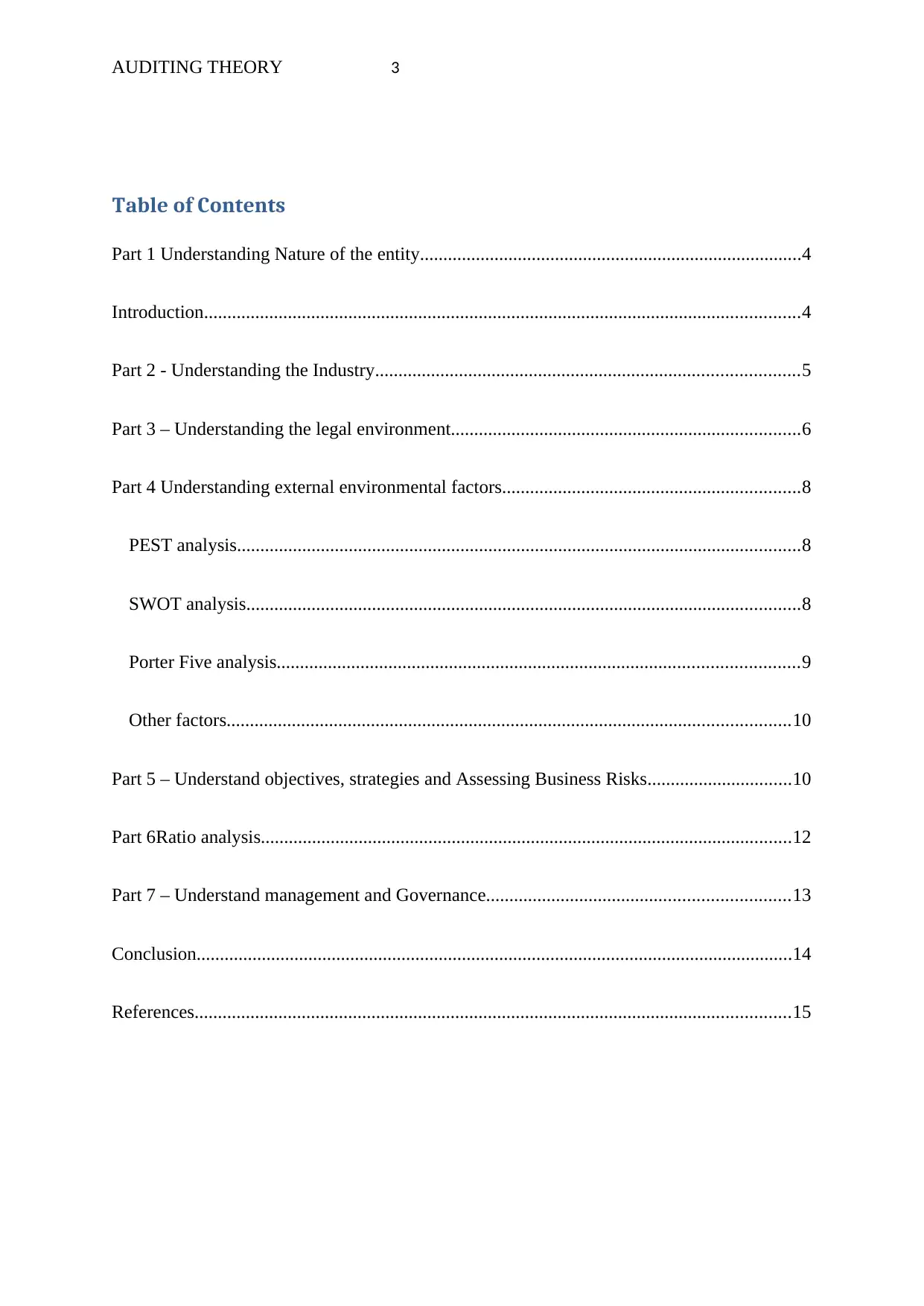
AUDITING THEORY 3
Table of Contents
Part 1 Understanding Nature of the entity..................................................................................4
Introduction................................................................................................................................4
Part 2 - Understanding the Industry...........................................................................................5
Part 3 – Understanding the legal environment...........................................................................6
Part 4 Understanding external environmental factors................................................................8
PEST analysis.........................................................................................................................8
SWOT analysis.......................................................................................................................8
Porter Five analysis................................................................................................................9
Other factors.........................................................................................................................10
Part 5 – Understand objectives, strategies and Assessing Business Risks...............................10
Part 6Ratio analysis..................................................................................................................12
Part 7 – Understand management and Governance.................................................................13
Conclusion................................................................................................................................14
References................................................................................................................................15
Table of Contents
Part 1 Understanding Nature of the entity..................................................................................4
Introduction................................................................................................................................4
Part 2 - Understanding the Industry...........................................................................................5
Part 3 – Understanding the legal environment...........................................................................6
Part 4 Understanding external environmental factors................................................................8
PEST analysis.........................................................................................................................8
SWOT analysis.......................................................................................................................8
Porter Five analysis................................................................................................................9
Other factors.........................................................................................................................10
Part 5 – Understand objectives, strategies and Assessing Business Risks...............................10
Part 6Ratio analysis..................................................................................................................12
Part 7 – Understand management and Governance.................................................................13
Conclusion................................................................................................................................14
References................................................................................................................................15
⊘ This is a preview!⊘
Do you want full access?
Subscribe today to unlock all pages.

Trusted by 1+ million students worldwide
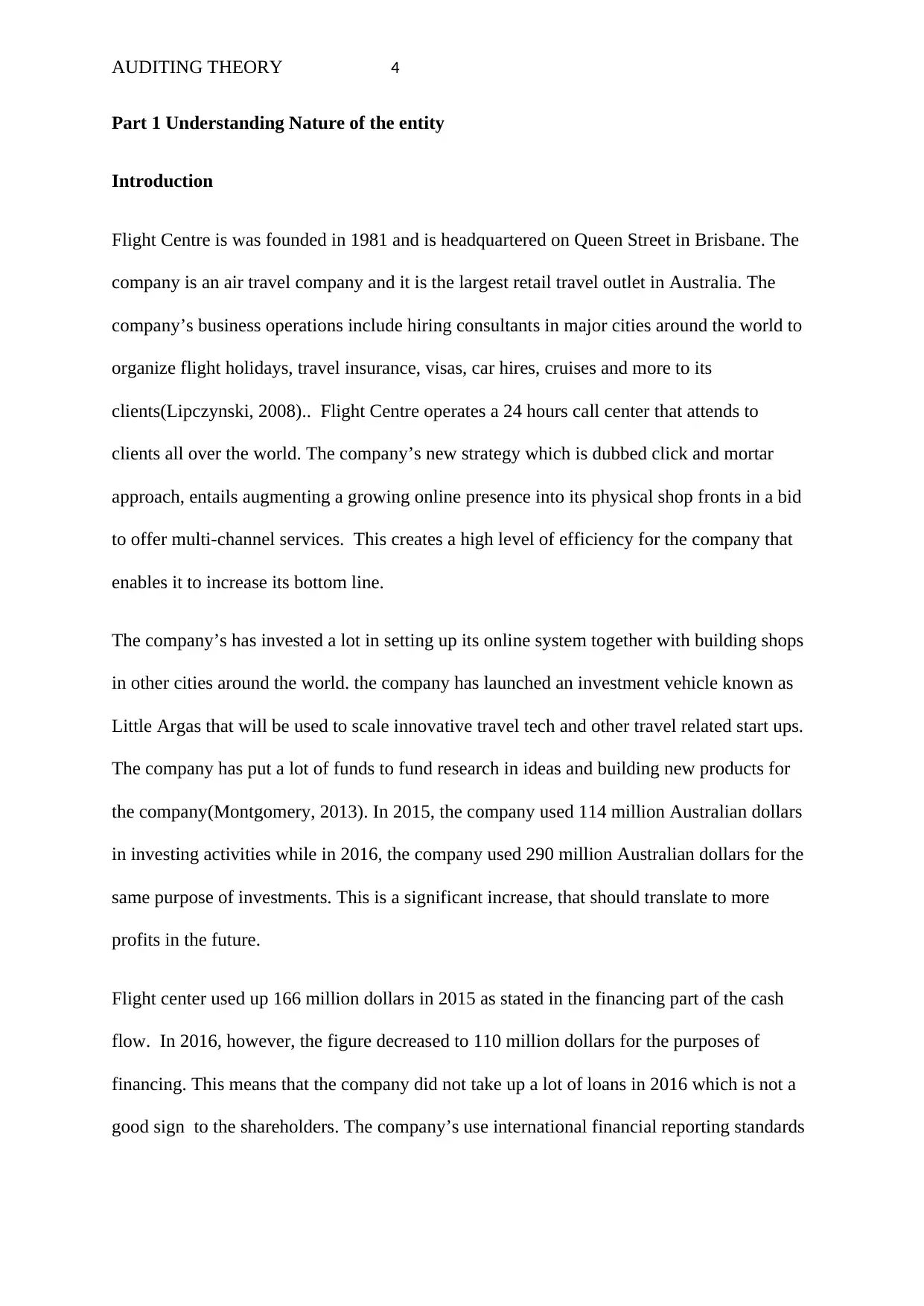
AUDITING THEORY 4
Part 1 Understanding Nature of the entity
Introduction
Flight Centre is was founded in 1981 and is headquartered on Queen Street in Brisbane. The
company is an air travel company and it is the largest retail travel outlet in Australia. The
company’s business operations include hiring consultants in major cities around the world to
organize flight holidays, travel insurance, visas, car hires, cruises and more to its
clients(Lipczynski, 2008).. Flight Centre operates a 24 hours call center that attends to
clients all over the world. The company’s new strategy which is dubbed click and mortar
approach, entails augmenting a growing online presence into its physical shop fronts in a bid
to offer multi-channel services. This creates a high level of efficiency for the company that
enables it to increase its bottom line.
The company’s has invested a lot in setting up its online system together with building shops
in other cities around the world. the company has launched an investment vehicle known as
Little Argas that will be used to scale innovative travel tech and other travel related start ups.
The company has put a lot of funds to fund research in ideas and building new products for
the company(Montgomery, 2013). In 2015, the company used 114 million Australian dollars
in investing activities while in 2016, the company used 290 million Australian dollars for the
same purpose of investments. This is a significant increase, that should translate to more
profits in the future.
Flight center used up 166 million dollars in 2015 as stated in the financing part of the cash
flow. In 2016, however, the figure decreased to 110 million dollars for the purposes of
financing. This means that the company did not take up a lot of loans in 2016 which is not a
good sign to the shareholders. The company’s use international financial reporting standards
Part 1 Understanding Nature of the entity
Introduction
Flight Centre is was founded in 1981 and is headquartered on Queen Street in Brisbane. The
company is an air travel company and it is the largest retail travel outlet in Australia. The
company’s business operations include hiring consultants in major cities around the world to
organize flight holidays, travel insurance, visas, car hires, cruises and more to its
clients(Lipczynski, 2008).. Flight Centre operates a 24 hours call center that attends to
clients all over the world. The company’s new strategy which is dubbed click and mortar
approach, entails augmenting a growing online presence into its physical shop fronts in a bid
to offer multi-channel services. This creates a high level of efficiency for the company that
enables it to increase its bottom line.
The company’s has invested a lot in setting up its online system together with building shops
in other cities around the world. the company has launched an investment vehicle known as
Little Argas that will be used to scale innovative travel tech and other travel related start ups.
The company has put a lot of funds to fund research in ideas and building new products for
the company(Montgomery, 2013). In 2015, the company used 114 million Australian dollars
in investing activities while in 2016, the company used 290 million Australian dollars for the
same purpose of investments. This is a significant increase, that should translate to more
profits in the future.
Flight center used up 166 million dollars in 2015 as stated in the financing part of the cash
flow. In 2016, however, the figure decreased to 110 million dollars for the purposes of
financing. This means that the company did not take up a lot of loans in 2016 which is not a
good sign to the shareholders. The company’s use international financial reporting standards
Paraphrase This Document
Need a fresh take? Get an instant paraphrase of this document with our AI Paraphraser
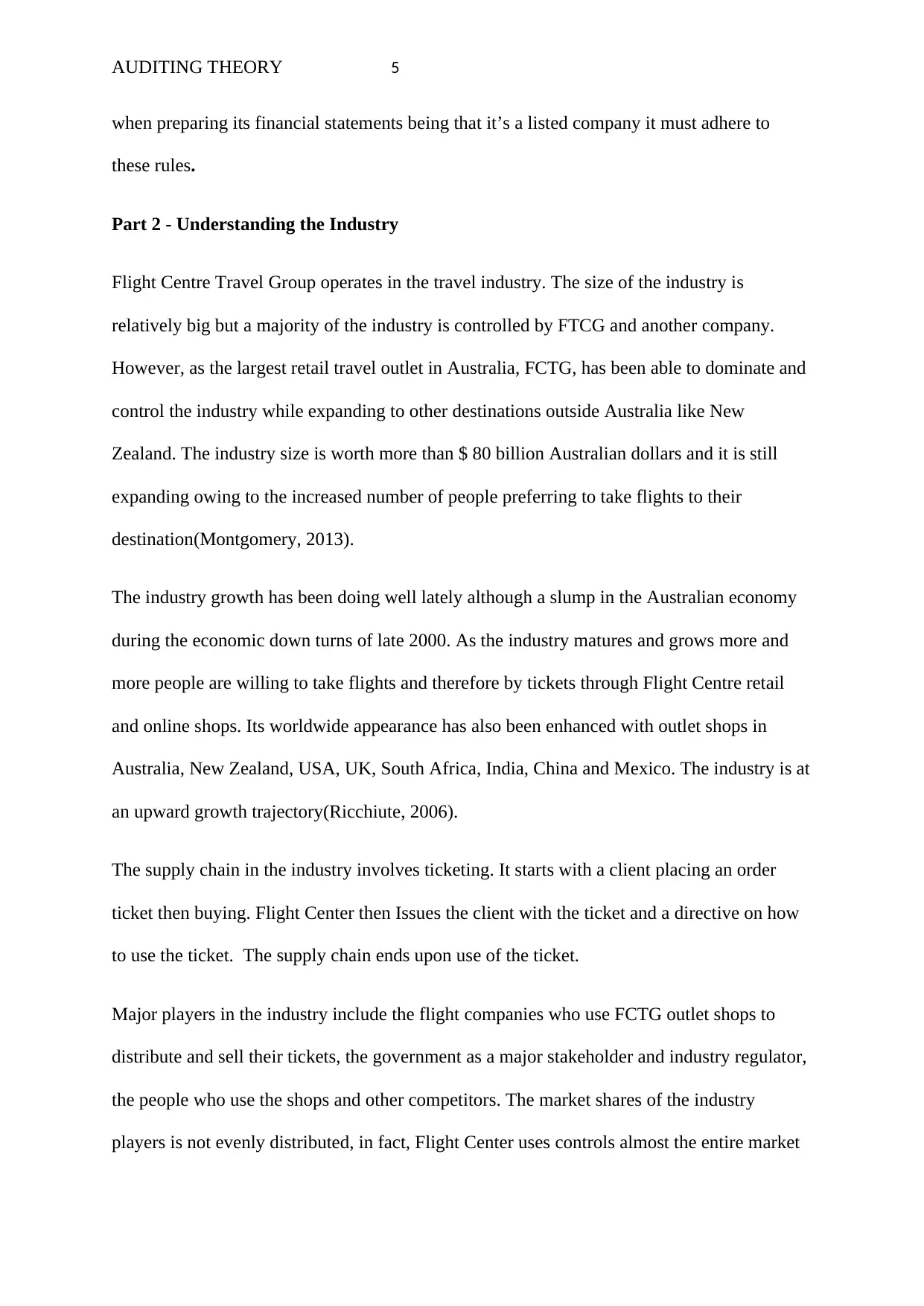
AUDITING THEORY 5
when preparing its financial statements being that it’s a listed company it must adhere to
these rules.
Part 2 - Understanding the Industry
Flight Centre Travel Group operates in the travel industry. The size of the industry is
relatively big but a majority of the industry is controlled by FTCG and another company.
However, as the largest retail travel outlet in Australia, FCTG, has been able to dominate and
control the industry while expanding to other destinations outside Australia like New
Zealand. The industry size is worth more than $ 80 billion Australian dollars and it is still
expanding owing to the increased number of people preferring to take flights to their
destination(Montgomery, 2013).
The industry growth has been doing well lately although a slump in the Australian economy
during the economic down turns of late 2000. As the industry matures and grows more and
more people are willing to take flights and therefore by tickets through Flight Centre retail
and online shops. Its worldwide appearance has also been enhanced with outlet shops in
Australia, New Zealand, USA, UK, South Africa, India, China and Mexico. The industry is at
an upward growth trajectory(Ricchiute, 2006).
The supply chain in the industry involves ticketing. It starts with a client placing an order
ticket then buying. Flight Center then Issues the client with the ticket and a directive on how
to use the ticket. The supply chain ends upon use of the ticket.
Major players in the industry include the flight companies who use FCTG outlet shops to
distribute and sell their tickets, the government as a major stakeholder and industry regulator,
the people who use the shops and other competitors. The market shares of the industry
players is not evenly distributed, in fact, Flight Center uses controls almost the entire market
when preparing its financial statements being that it’s a listed company it must adhere to
these rules.
Part 2 - Understanding the Industry
Flight Centre Travel Group operates in the travel industry. The size of the industry is
relatively big but a majority of the industry is controlled by FTCG and another company.
However, as the largest retail travel outlet in Australia, FCTG, has been able to dominate and
control the industry while expanding to other destinations outside Australia like New
Zealand. The industry size is worth more than $ 80 billion Australian dollars and it is still
expanding owing to the increased number of people preferring to take flights to their
destination(Montgomery, 2013).
The industry growth has been doing well lately although a slump in the Australian economy
during the economic down turns of late 2000. As the industry matures and grows more and
more people are willing to take flights and therefore by tickets through Flight Centre retail
and online shops. Its worldwide appearance has also been enhanced with outlet shops in
Australia, New Zealand, USA, UK, South Africa, India, China and Mexico. The industry is at
an upward growth trajectory(Ricchiute, 2006).
The supply chain in the industry involves ticketing. It starts with a client placing an order
ticket then buying. Flight Center then Issues the client with the ticket and a directive on how
to use the ticket. The supply chain ends upon use of the ticket.
Major players in the industry include the flight companies who use FCTG outlet shops to
distribute and sell their tickets, the government as a major stakeholder and industry regulator,
the people who use the shops and other competitors. The market shares of the industry
players is not evenly distributed, in fact, Flight Center uses controls almost the entire market
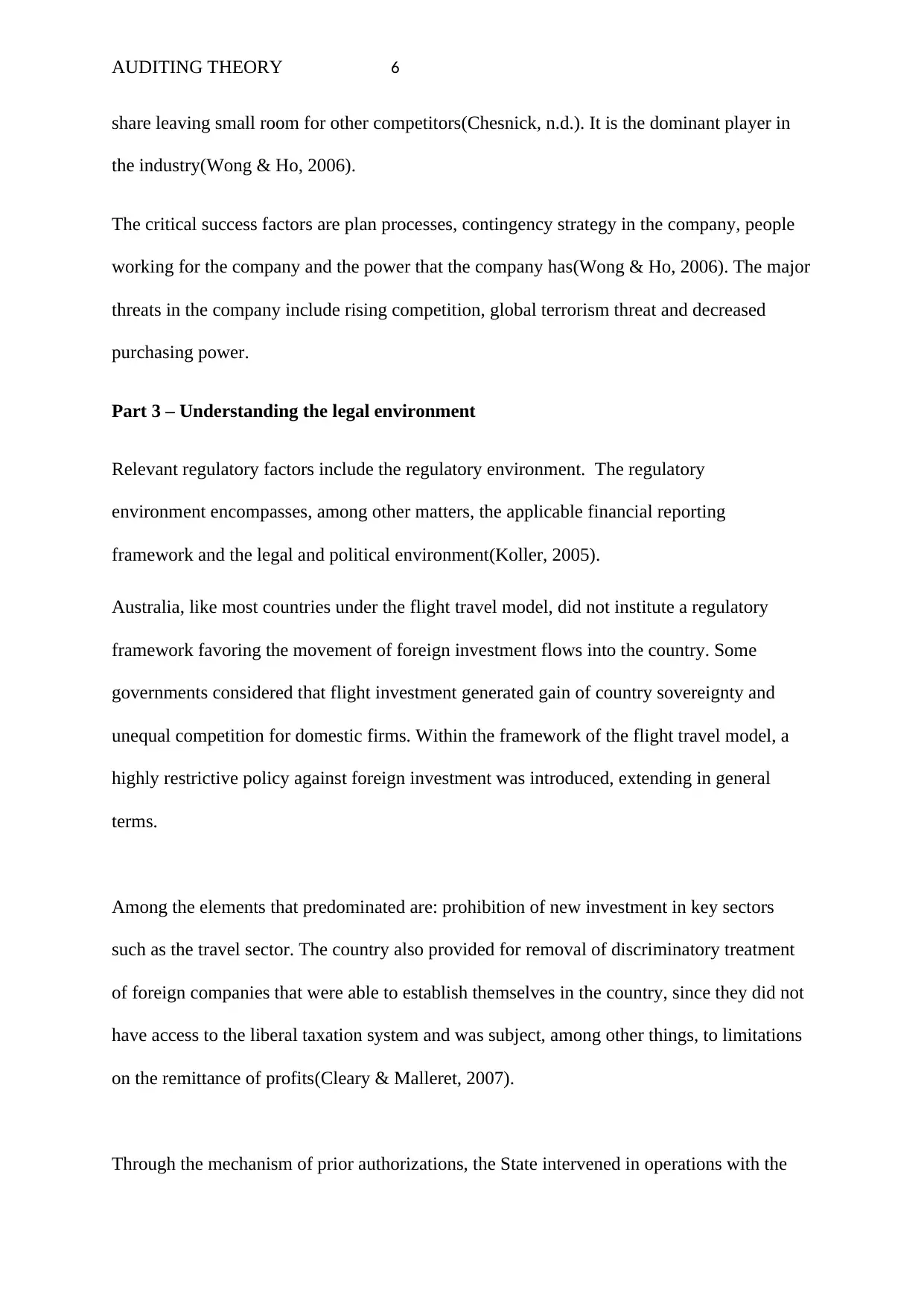
AUDITING THEORY 6
share leaving small room for other competitors(Chesnick, n.d.). It is the dominant player in
the industry(Wong & Ho, 2006).
The critical success factors are plan processes, contingency strategy in the company, people
working for the company and the power that the company has(Wong & Ho, 2006). The major
threats in the company include rising competition, global terrorism threat and decreased
purchasing power.
Part 3 – Understanding the legal environment
Relevant regulatory factors include the regulatory environment. The regulatory
environment encompasses, among other matters, the applicable financial reporting
framework and the legal and political environment(Koller, 2005).
Australia, like most countries under the flight travel model, did not institute a regulatory
framework favoring the movement of foreign investment flows into the country. Some
governments considered that flight investment generated gain of country sovereignty and
unequal competition for domestic firms. Within the framework of the flight travel model, a
highly restrictive policy against foreign investment was introduced, extending in general
terms.
Among the elements that predominated are: prohibition of new investment in key sectors
such as the travel sector. The country also provided for removal of discriminatory treatment
of foreign companies that were able to establish themselves in the country, since they did not
have access to the liberal taxation system and was subject, among other things, to limitations
on the remittance of profits(Cleary & Malleret, 2007).
Through the mechanism of prior authorizations, the State intervened in operations with the
share leaving small room for other competitors(Chesnick, n.d.). It is the dominant player in
the industry(Wong & Ho, 2006).
The critical success factors are plan processes, contingency strategy in the company, people
working for the company and the power that the company has(Wong & Ho, 2006). The major
threats in the company include rising competition, global terrorism threat and decreased
purchasing power.
Part 3 – Understanding the legal environment
Relevant regulatory factors include the regulatory environment. The regulatory
environment encompasses, among other matters, the applicable financial reporting
framework and the legal and political environment(Koller, 2005).
Australia, like most countries under the flight travel model, did not institute a regulatory
framework favoring the movement of foreign investment flows into the country. Some
governments considered that flight investment generated gain of country sovereignty and
unequal competition for domestic firms. Within the framework of the flight travel model, a
highly restrictive policy against foreign investment was introduced, extending in general
terms.
Among the elements that predominated are: prohibition of new investment in key sectors
such as the travel sector. The country also provided for removal of discriminatory treatment
of foreign companies that were able to establish themselves in the country, since they did not
have access to the liberal taxation system and was subject, among other things, to limitations
on the remittance of profits(Cleary & Malleret, 2007).
Through the mechanism of prior authorizations, the State intervened in operations with the
⊘ This is a preview!⊘
Do you want full access?
Subscribe today to unlock all pages.

Trusted by 1+ million students worldwide
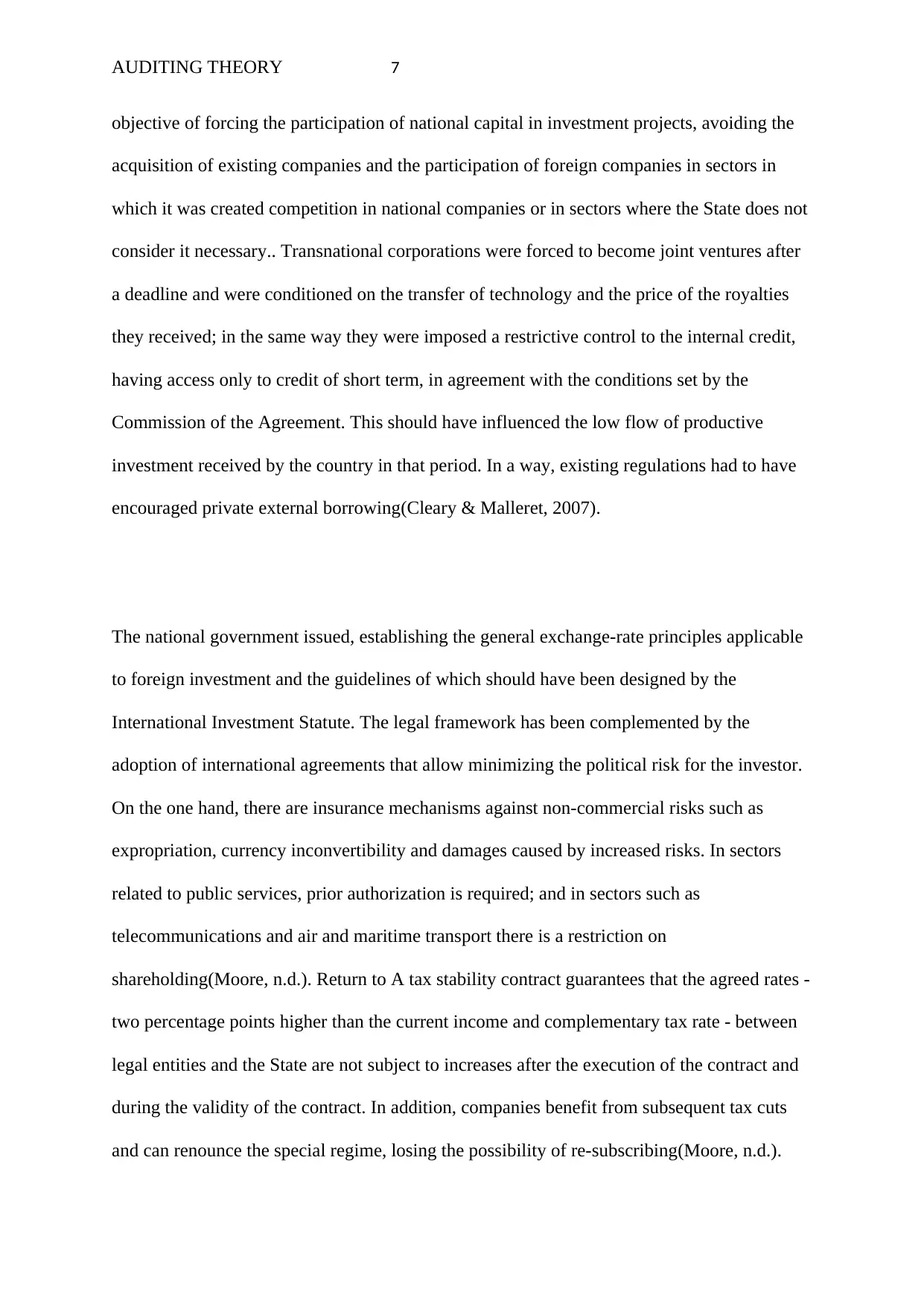
AUDITING THEORY 7
objective of forcing the participation of national capital in investment projects, avoiding the
acquisition of existing companies and the participation of foreign companies in sectors in
which it was created competition in national companies or in sectors where the State does not
consider it necessary.. Transnational corporations were forced to become joint ventures after
a deadline and were conditioned on the transfer of technology and the price of the royalties
they received; in the same way they were imposed a restrictive control to the internal credit,
having access only to credit of short term, in agreement with the conditions set by the
Commission of the Agreement. This should have influenced the low flow of productive
investment received by the country in that period. In a way, existing regulations had to have
encouraged private external borrowing(Cleary & Malleret, 2007).
The national government issued, establishing the general exchange-rate principles applicable
to foreign investment and the guidelines of which should have been designed by the
International Investment Statute. The legal framework has been complemented by the
adoption of international agreements that allow minimizing the political risk for the investor.
On the one hand, there are insurance mechanisms against non-commercial risks such as
expropriation, currency inconvertibility and damages caused by increased risks. In sectors
related to public services, prior authorization is required; and in sectors such as
telecommunications and air and maritime transport there is a restriction on
shareholding(Moore, n.d.). Return to A tax stability contract guarantees that the agreed rates -
two percentage points higher than the current income and complementary tax rate - between
legal entities and the State are not subject to increases after the execution of the contract and
during the validity of the contract. In addition, companies benefit from subsequent tax cuts
and can renounce the special regime, losing the possibility of re-subscribing(Moore, n.d.).
objective of forcing the participation of national capital in investment projects, avoiding the
acquisition of existing companies and the participation of foreign companies in sectors in
which it was created competition in national companies or in sectors where the State does not
consider it necessary.. Transnational corporations were forced to become joint ventures after
a deadline and were conditioned on the transfer of technology and the price of the royalties
they received; in the same way they were imposed a restrictive control to the internal credit,
having access only to credit of short term, in agreement with the conditions set by the
Commission of the Agreement. This should have influenced the low flow of productive
investment received by the country in that period. In a way, existing regulations had to have
encouraged private external borrowing(Cleary & Malleret, 2007).
The national government issued, establishing the general exchange-rate principles applicable
to foreign investment and the guidelines of which should have been designed by the
International Investment Statute. The legal framework has been complemented by the
adoption of international agreements that allow minimizing the political risk for the investor.
On the one hand, there are insurance mechanisms against non-commercial risks such as
expropriation, currency inconvertibility and damages caused by increased risks. In sectors
related to public services, prior authorization is required; and in sectors such as
telecommunications and air and maritime transport there is a restriction on
shareholding(Moore, n.d.). Return to A tax stability contract guarantees that the agreed rates -
two percentage points higher than the current income and complementary tax rate - between
legal entities and the State are not subject to increases after the execution of the contract and
during the validity of the contract. In addition, companies benefit from subsequent tax cuts
and can renounce the special regime, losing the possibility of re-subscribing(Moore, n.d.).
Paraphrase This Document
Need a fresh take? Get an instant paraphrase of this document with our AI Paraphraser
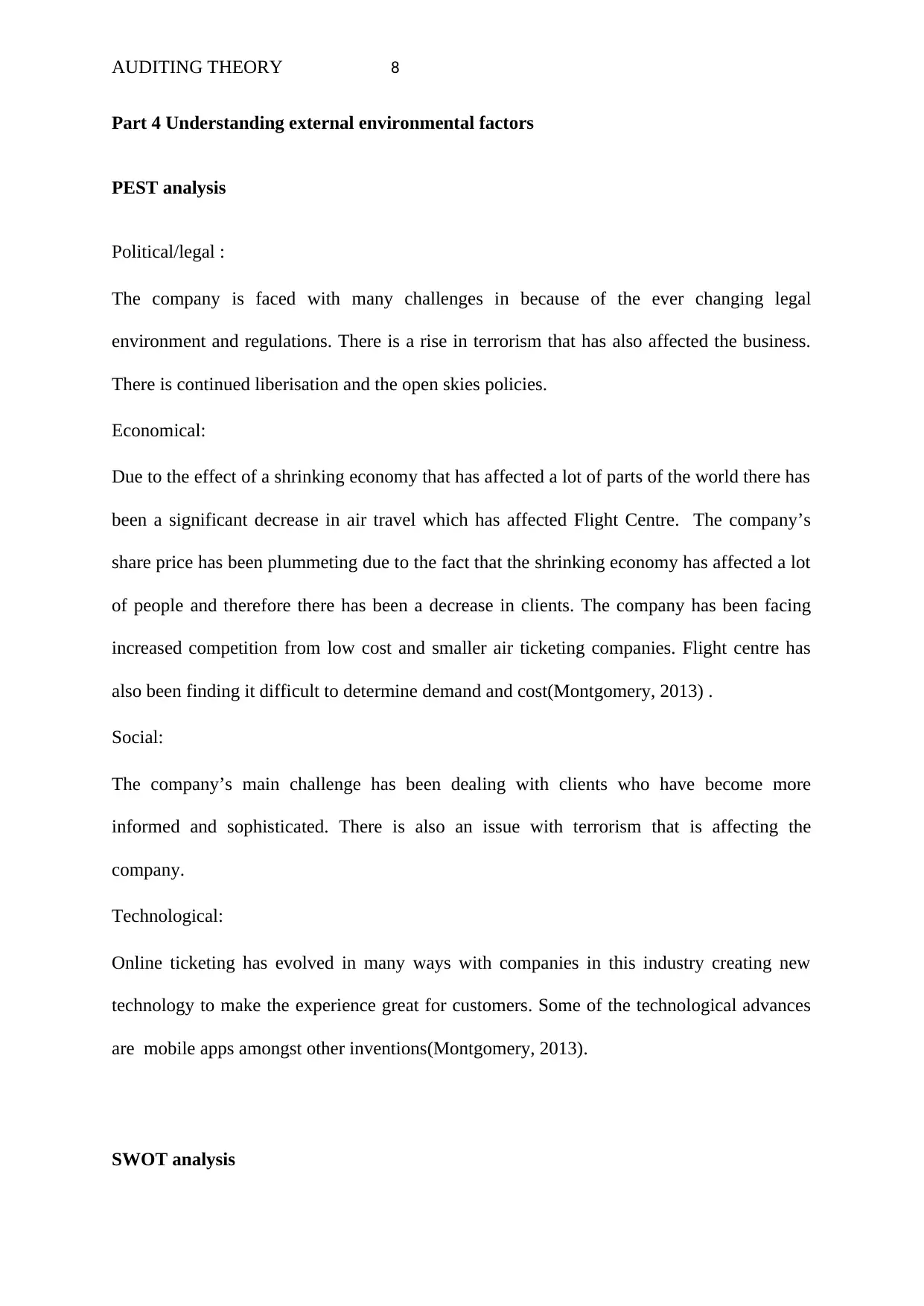
AUDITING THEORY 8
Part 4 Understanding external environmental factors
PEST analysis
Political/legal :
The company is faced with many challenges in because of the ever changing legal
environment and regulations. There is a rise in terrorism that has also affected the business.
There is continued liberisation and the open skies policies.
Economical:
Due to the effect of a shrinking economy that has affected a lot of parts of the world there has
been a significant decrease in air travel which has affected Flight Centre. The company’s
share price has been plummeting due to the fact that the shrinking economy has affected a lot
of people and therefore there has been a decrease in clients. The company has been facing
increased competition from low cost and smaller air ticketing companies. Flight centre has
also been finding it difficult to determine demand and cost(Montgomery, 2013) .
Social:
The company’s main challenge has been dealing with clients who have become more
informed and sophisticated. There is also an issue with terrorism that is affecting the
company.
Technological:
Online ticketing has evolved in many ways with companies in this industry creating new
technology to make the experience great for customers. Some of the technological advances
are mobile apps amongst other inventions(Montgomery, 2013).
SWOT analysis
Part 4 Understanding external environmental factors
PEST analysis
Political/legal :
The company is faced with many challenges in because of the ever changing legal
environment and regulations. There is a rise in terrorism that has also affected the business.
There is continued liberisation and the open skies policies.
Economical:
Due to the effect of a shrinking economy that has affected a lot of parts of the world there has
been a significant decrease in air travel which has affected Flight Centre. The company’s
share price has been plummeting due to the fact that the shrinking economy has affected a lot
of people and therefore there has been a decrease in clients. The company has been facing
increased competition from low cost and smaller air ticketing companies. Flight centre has
also been finding it difficult to determine demand and cost(Montgomery, 2013) .
Social:
The company’s main challenge has been dealing with clients who have become more
informed and sophisticated. There is also an issue with terrorism that is affecting the
company.
Technological:
Online ticketing has evolved in many ways with companies in this industry creating new
technology to make the experience great for customers. Some of the technological advances
are mobile apps amongst other inventions(Montgomery, 2013).
SWOT analysis
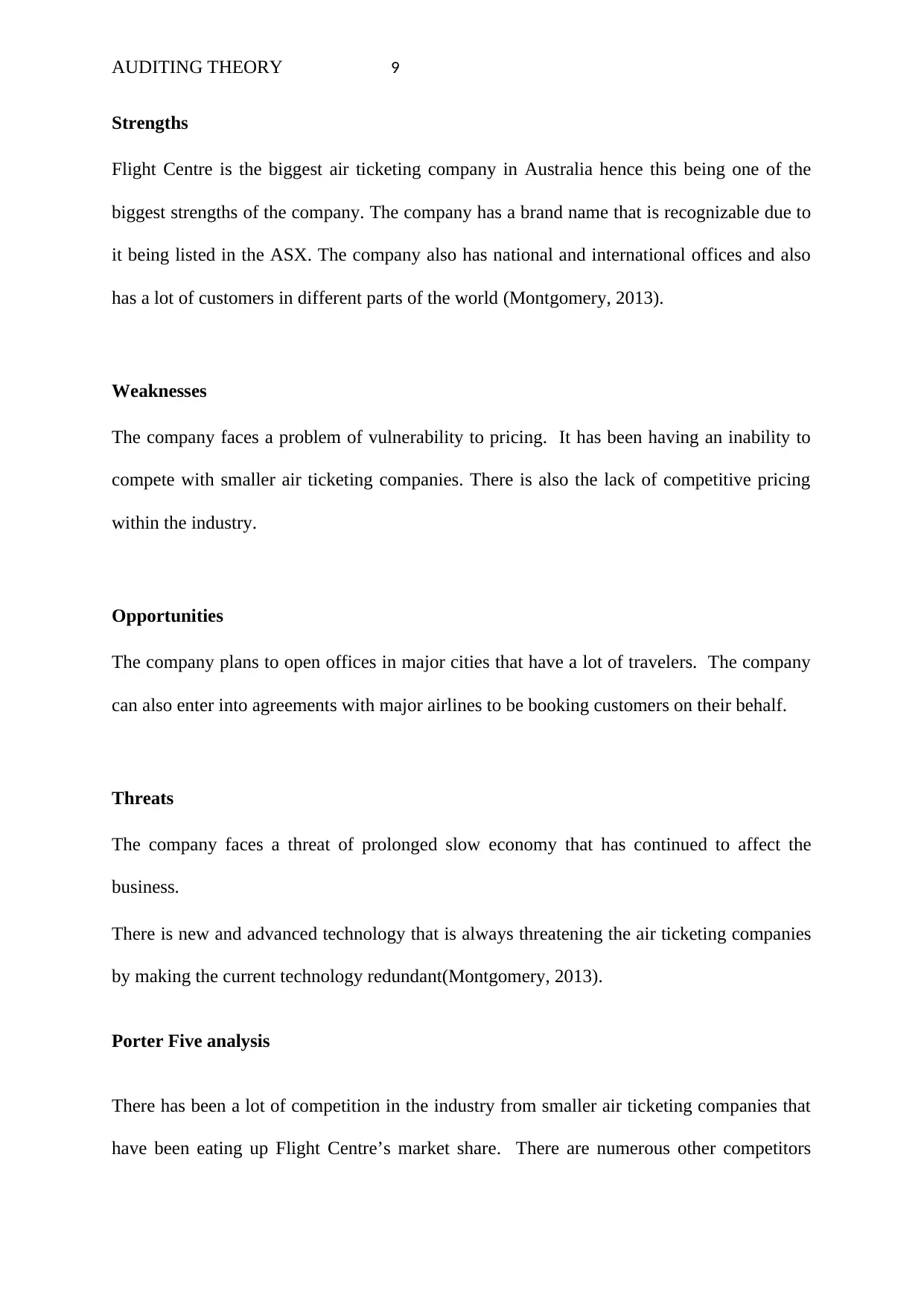
AUDITING THEORY 9
Strengths
Flight Centre is the biggest air ticketing company in Australia hence this being one of the
biggest strengths of the company. The company has a brand name that is recognizable due to
it being listed in the ASX. The company also has national and international offices and also
has a lot of customers in different parts of the world (Montgomery, 2013).
Weaknesses
The company faces a problem of vulnerability to pricing. It has been having an inability to
compete with smaller air ticketing companies. There is also the lack of competitive pricing
within the industry.
Opportunities
The company plans to open offices in major cities that have a lot of travelers. The company
can also enter into agreements with major airlines to be booking customers on their behalf.
Threats
The company faces a threat of prolonged slow economy that has continued to affect the
business.
There is new and advanced technology that is always threatening the air ticketing companies
by making the current technology redundant(Montgomery, 2013).
Porter Five analysis
There has been a lot of competition in the industry from smaller air ticketing companies that
have been eating up Flight Centre’s market share. There are numerous other competitors
Strengths
Flight Centre is the biggest air ticketing company in Australia hence this being one of the
biggest strengths of the company. The company has a brand name that is recognizable due to
it being listed in the ASX. The company also has national and international offices and also
has a lot of customers in different parts of the world (Montgomery, 2013).
Weaknesses
The company faces a problem of vulnerability to pricing. It has been having an inability to
compete with smaller air ticketing companies. There is also the lack of competitive pricing
within the industry.
Opportunities
The company plans to open offices in major cities that have a lot of travelers. The company
can also enter into agreements with major airlines to be booking customers on their behalf.
Threats
The company faces a threat of prolonged slow economy that has continued to affect the
business.
There is new and advanced technology that is always threatening the air ticketing companies
by making the current technology redundant(Montgomery, 2013).
Porter Five analysis
There has been a lot of competition in the industry from smaller air ticketing companies that
have been eating up Flight Centre’s market share. There are numerous other competitors
⊘ This is a preview!⊘
Do you want full access?
Subscribe today to unlock all pages.

Trusted by 1+ million students worldwide
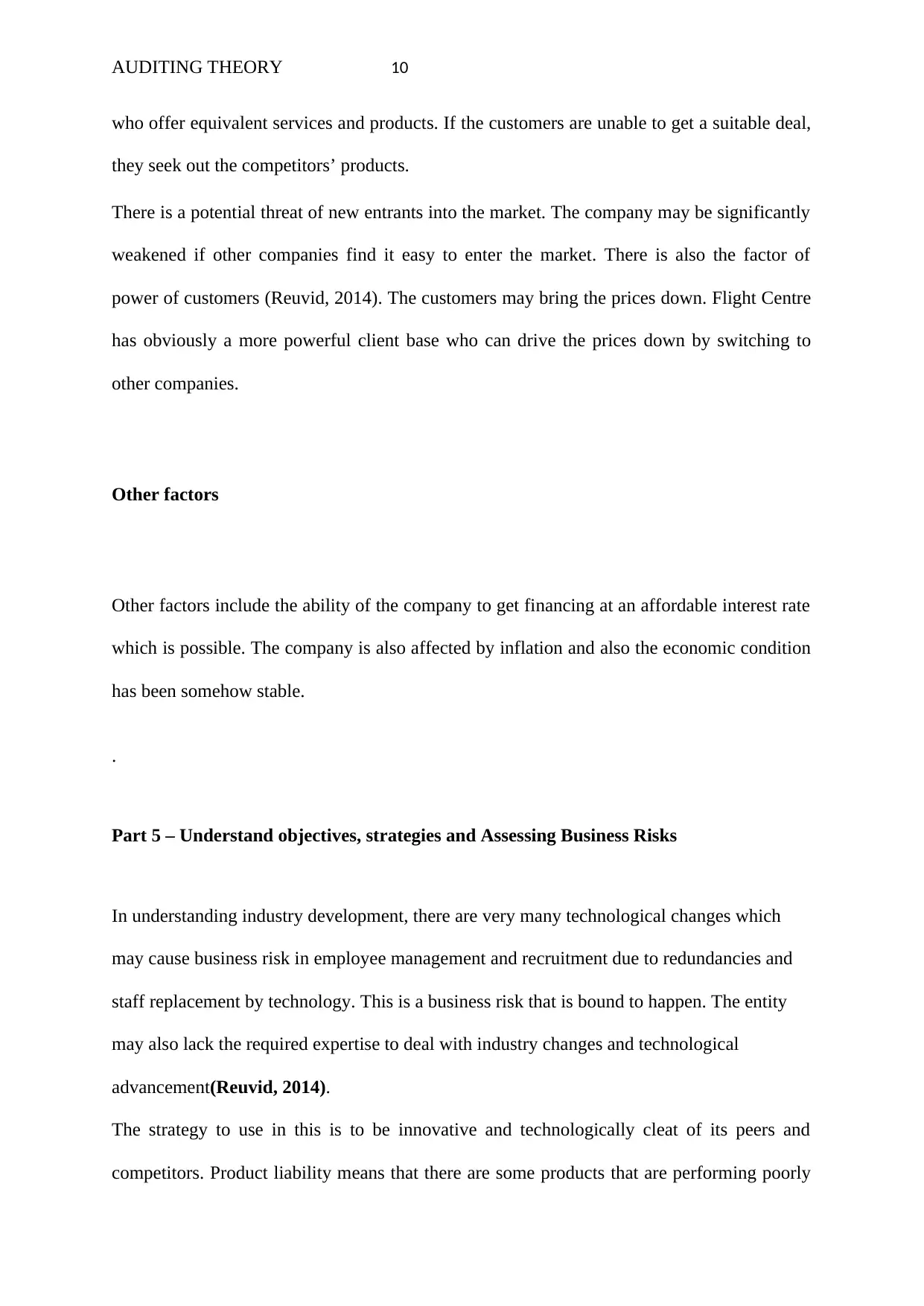
AUDITING THEORY 10
who offer equivalent services and products. If the customers are unable to get a suitable deal,
they seek out the competitors’ products.
There is a potential threat of new entrants into the market. The company may be significantly
weakened if other companies find it easy to enter the market. There is also the factor of
power of customers (Reuvid, 2014). The customers may bring the prices down. Flight Centre
has obviously a more powerful client base who can drive the prices down by switching to
other companies.
Other factors
Other factors include the ability of the company to get financing at an affordable interest rate
which is possible. The company is also affected by inflation and also the economic condition
has been somehow stable.
.
Part 5 – Understand objectives, strategies and Assessing Business Risks
In understanding industry development, there are very many technological changes which
may cause business risk in employee management and recruitment due to redundancies and
staff replacement by technology. This is a business risk that is bound to happen. The entity
may also lack the required expertise to deal with industry changes and technological
advancement(Reuvid, 2014).
The strategy to use in this is to be innovative and technologically cleat of its peers and
competitors. Product liability means that there are some products that are performing poorly
who offer equivalent services and products. If the customers are unable to get a suitable deal,
they seek out the competitors’ products.
There is a potential threat of new entrants into the market. The company may be significantly
weakened if other companies find it easy to enter the market. There is also the factor of
power of customers (Reuvid, 2014). The customers may bring the prices down. Flight Centre
has obviously a more powerful client base who can drive the prices down by switching to
other companies.
Other factors
Other factors include the ability of the company to get financing at an affordable interest rate
which is possible. The company is also affected by inflation and also the economic condition
has been somehow stable.
.
Part 5 – Understand objectives, strategies and Assessing Business Risks
In understanding industry development, there are very many technological changes which
may cause business risk in employee management and recruitment due to redundancies and
staff replacement by technology. This is a business risk that is bound to happen. The entity
may also lack the required expertise to deal with industry changes and technological
advancement(Reuvid, 2014).
The strategy to use in this is to be innovative and technologically cleat of its peers and
competitors. Product liability means that there are some products that are performing poorly
Paraphrase This Document
Need a fresh take? Get an instant paraphrase of this document with our AI Paraphraser
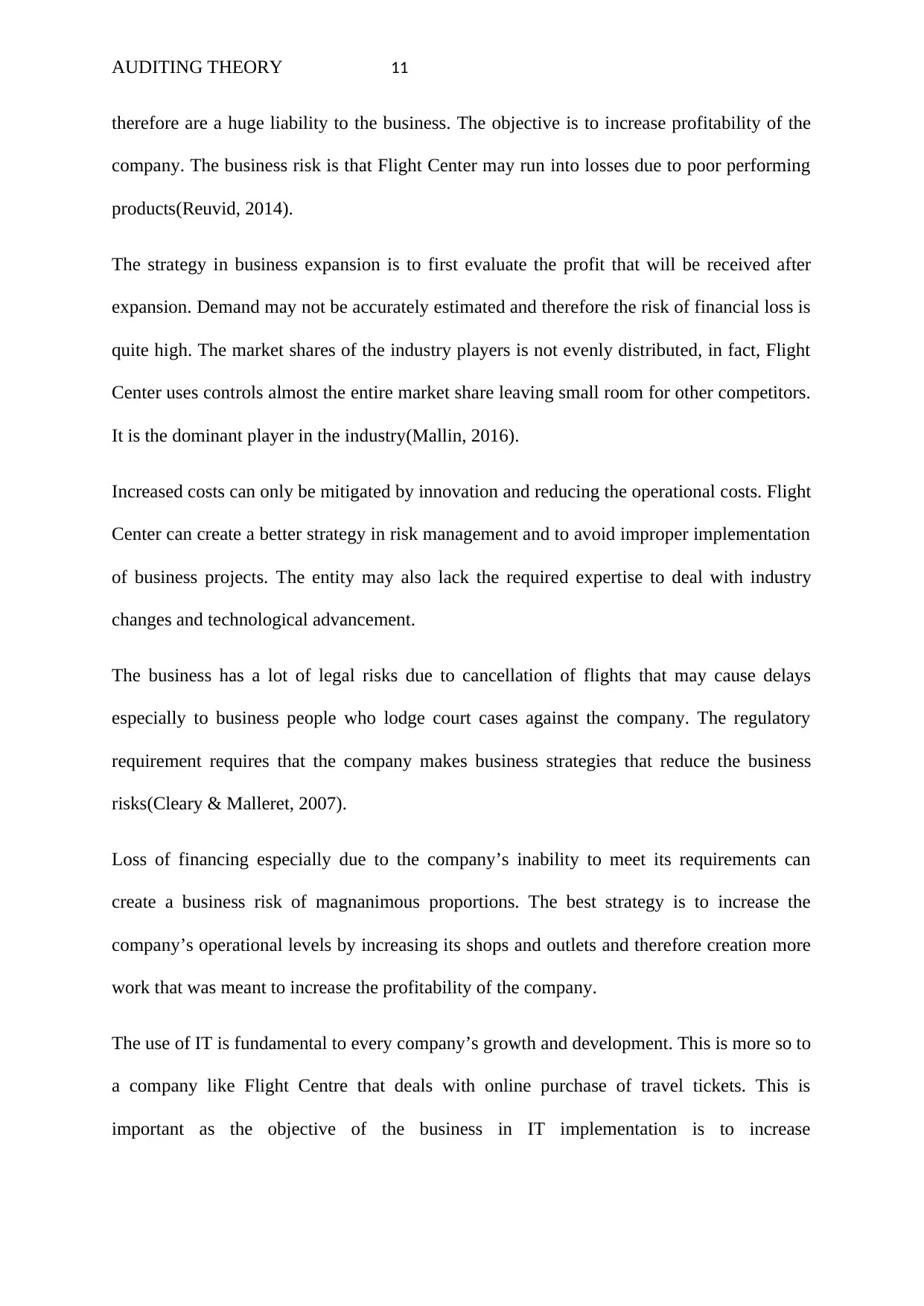
AUDITING THEORY 11
therefore are a huge liability to the business. The objective is to increase profitability of the
company. The business risk is that Flight Center may run into losses due to poor performing
products(Reuvid, 2014).
The strategy in business expansion is to first evaluate the profit that will be received after
expansion. Demand may not be accurately estimated and therefore the risk of financial loss is
quite high. The market shares of the industry players is not evenly distributed, in fact, Flight
Center uses controls almost the entire market share leaving small room for other competitors.
It is the dominant player in the industry(Mallin, 2016).
Increased costs can only be mitigated by innovation and reducing the operational costs. Flight
Center can create a better strategy in risk management and to avoid improper implementation
of business projects. The entity may also lack the required expertise to deal with industry
changes and technological advancement.
The business has a lot of legal risks due to cancellation of flights that may cause delays
especially to business people who lodge court cases against the company. The regulatory
requirement requires that the company makes business strategies that reduce the business
risks(Cleary & Malleret, 2007).
Loss of financing especially due to the company’s inability to meet its requirements can
create a business risk of magnanimous proportions. The best strategy is to increase the
company’s operational levels by increasing its shops and outlets and therefore creation more
work that was meant to increase the profitability of the company.
The use of IT is fundamental to every company’s growth and development. This is more so to
a company like Flight Centre that deals with online purchase of travel tickets. This is
important as the objective of the business in IT implementation is to increase
therefore are a huge liability to the business. The objective is to increase profitability of the
company. The business risk is that Flight Center may run into losses due to poor performing
products(Reuvid, 2014).
The strategy in business expansion is to first evaluate the profit that will be received after
expansion. Demand may not be accurately estimated and therefore the risk of financial loss is
quite high. The market shares of the industry players is not evenly distributed, in fact, Flight
Center uses controls almost the entire market share leaving small room for other competitors.
It is the dominant player in the industry(Mallin, 2016).
Increased costs can only be mitigated by innovation and reducing the operational costs. Flight
Center can create a better strategy in risk management and to avoid improper implementation
of business projects. The entity may also lack the required expertise to deal with industry
changes and technological advancement.
The business has a lot of legal risks due to cancellation of flights that may cause delays
especially to business people who lodge court cases against the company. The regulatory
requirement requires that the company makes business strategies that reduce the business
risks(Cleary & Malleret, 2007).
Loss of financing especially due to the company’s inability to meet its requirements can
create a business risk of magnanimous proportions. The best strategy is to increase the
company’s operational levels by increasing its shops and outlets and therefore creation more
work that was meant to increase the profitability of the company.
The use of IT is fundamental to every company’s growth and development. This is more so to
a company like Flight Centre that deals with online purchase of travel tickets. This is
important as the objective of the business in IT implementation is to increase
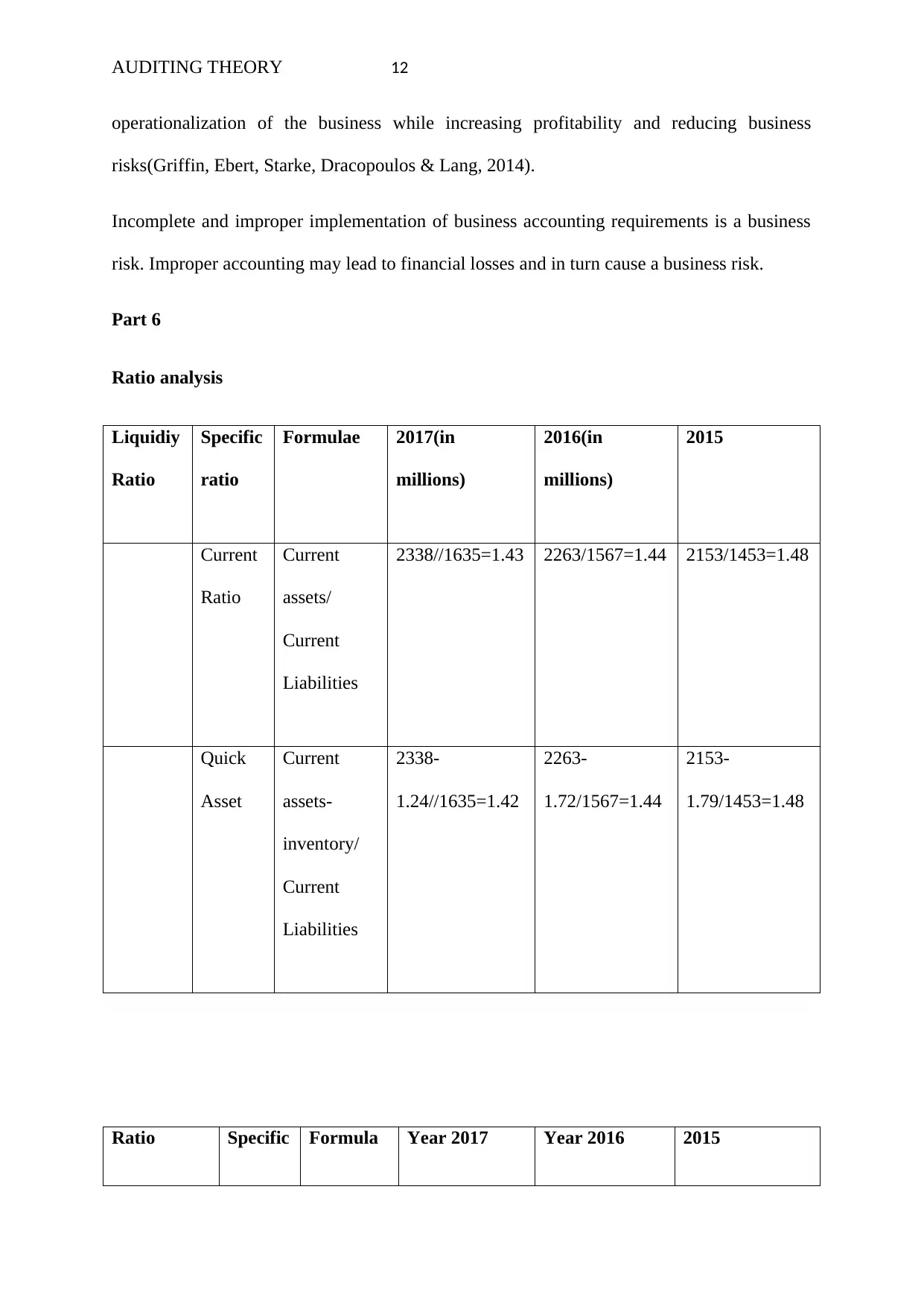
AUDITING THEORY 12
operationalization of the business while increasing profitability and reducing business
risks(Griffin, Ebert, Starke, Dracopoulos & Lang, 2014).
Incomplete and improper implementation of business accounting requirements is a business
risk. Improper accounting may lead to financial losses and in turn cause a business risk.
Part 6
Ratio analysis
Liquidiy
Ratio
Specific
ratio
Formulae 2017(in
millions)
2016(in
millions)
2015
Current
Ratio
Current
assets/
Current
Liabilities
2338//1635=1.43 2263/1567=1.44 2153/1453=1.48
Quick
Asset
Current
assets-
inventory/
Current
Liabilities
2338-
1.24//1635=1.42
2263-
1.72/1567=1.44
2153-
1.79/1453=1.48
Ratio Specific Formula Year 2017 Year 2016 2015
operationalization of the business while increasing profitability and reducing business
risks(Griffin, Ebert, Starke, Dracopoulos & Lang, 2014).
Incomplete and improper implementation of business accounting requirements is a business
risk. Improper accounting may lead to financial losses and in turn cause a business risk.
Part 6
Ratio analysis
Liquidiy
Ratio
Specific
ratio
Formulae 2017(in
millions)
2016(in
millions)
2015
Current
Ratio
Current
assets/
Current
Liabilities
2338//1635=1.43 2263/1567=1.44 2153/1453=1.48
Quick
Asset
Current
assets-
inventory/
Current
Liabilities
2338-
1.24//1635=1.42
2263-
1.72/1567=1.44
2153-
1.79/1453=1.48
Ratio Specific Formula Year 2017 Year 2016 2015
⊘ This is a preview!⊘
Do you want full access?
Subscribe today to unlock all pages.

Trusted by 1+ million students worldwide
1 out of 16
Related Documents
Your All-in-One AI-Powered Toolkit for Academic Success.
+13062052269
info@desklib.com
Available 24*7 on WhatsApp / Email
![[object Object]](/_next/static/media/star-bottom.7253800d.svg)
Unlock your academic potential
Copyright © 2020–2025 A2Z Services. All Rights Reserved. Developed and managed by ZUCOL.





